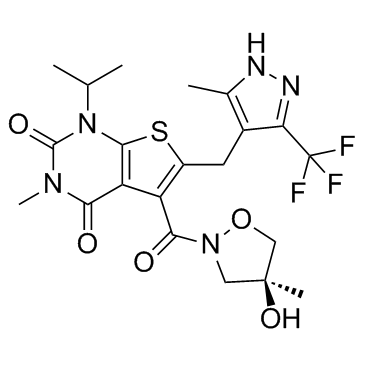1448671-31-5
| Name | 5-{[(4S)-4-Hydroxy-4-methyl-1,2-oxazolidin-2-yl]carbonyl}-1-isopropyl-3-methyl-6-{[5-methyl-3-(trifluoromethyl)-1H-pyrazol-4-yl]methyl}thieno[2,3-d]pyrimidine-2,4(1H,3H)-dione |
|---|---|
| Synonyms |
Thieno[2,3-d]pyrimidine-2,4(1H,3H)-dione, 5-[[(4S)-4-hydroxy-4-methyl-2-isoxazolidinyl]carbonyl]-3-methyl-1-(1-methylethyl)-6-[[5-methyl-3-(trifluoromethyl)-1H-pyrazol-4-yl]methyl]-
5-{[(4S)-4-Hydroxy-4-methyl-1,2-oxazolidin-2-yl]carbonyl}-1-isopropyl-3-methyl-6-{[5-methyl-3-(trifluoromethyl)-1H-pyrazol-4-yl]methyl}thieno[2,3-d]pyrimidine-2,4(1H,3H)-dione AZD-3965 AZD3965 |
| Description | AZD3965 is a selective MCT1 inhibitor with a Ki of 1.6 nM, showing 6-fold selectivity over MCT2. |
|---|---|
| Related Catalog | |
| Target |
Ki: 1.6 nM (MCT1)[1] |
| In Vitro | AZD3965 is designed to selectively inhibit Monocarboxylate transporter-1 (MCT1) and will therefore be expected to influence the movement of lactate into and out of cells[1]. AZD3965 treatment causes a 3.7 fold increase in intracellular lactate in hypoxic COR-L103 and 3.7 fold and 3.9 fold increases in normoxic and hypoxic NCI-H1048 cells respectively. In all other cases a <1.9 fold increase is observed. These data are consistent with AZD3965 blocking lactate transport in cells where AZD3965 also reduces cell number and is consistent with AZD3965 acting via inhibition of MCT1. When MCT1 is overexpressed the EC50 of NCI-H1048 is increased from 0.14 nM to 10.5 nM in NCI-H1048 cells. This is consistent with AZD3965 acting via MCT1 inhibition[2]. |
| In Vivo | COR-L103 tumor bearing mice are treated with 100 mg/kg AZD3965 or vehicle BIDfor 21 days and the tumor volume monitored. Pharmacokinetic analysis demonstrates that 100 mg/kg AZD3965 BID results in concentrations of free AZD3965 predicted to inhibit lactate transport. AZD3965 treatment significantly reduces the growth of COR-L103 tumors, although tumor regression is not seen, consistent with AZD3965 only targeting the hypoxic fraction of the tumor[2]. |
| Kinase Assay | Cells are plated overnight and treated with 100 nM AZD3965 or vehicle for 24 hours. The cells are then washed, once in PBS and twice with lysis buffer (50 mM Mops, 100 mM KCl, 5 mM MgCl2, 1 mM EDTA, 0.1 mM DTT, 1 mM PMSF supplemented with 1× mini complete protease inhibitor cocktail tablets. The cells are harvested by scraping and centrifugation, and the pellet snap frozen without buffer in liquid nitrogen. Frozen aliquots of cells are thawed on ice and re-suspended in lysis buffer. Cells are lysed by 3 rounds of freezing in liquid nitrogen and thawing at 37°C for 2 minutes each. Lysates are subsequently centrifuged (13000 g, 10min, 4°C) until clear and then stored on ice. Enzyme activity in the cell lysates is determined using a micro-plate reader to measure either production or depletion of NADH/NADPH, through its absorbance at 340/10 nm, occurring as a result of direct or coupled enzyme reactions. The 96 well plates used for the assays are pre-heated to 37°C for 10 minutes prior to starting reactions, initiated by the addition of 5 μL cell lysate to 95 μL of reaction buffer (50 mM Mops pH 7.4, 100 mM KCl, 5 mM free magnesium). The standard reaction buffer is supplemented to assay the kinetics of the different enzymes. Absorbance values for controls are subtracted from absorbance of corresponding reactions. Graphpad prism 6 is used to plot V0 values against substrate concentration and determine Vmax and Km values. The Vmax is then normalised to the protein concentration in the cell lysate[1]. |
| Animal Admin | Mice[2] COR-L103 xenografts are grown by subcutaneous injection of 5×106 cells in 0.2 mL of 1:1 serum-free RPMI:Matrigel into the mid-dorsal flank of 8 to 14-week-old male NOD scid gamma mice. Mice are housed in individually vented caging systems in a 12-hour light/12-hour dark environment and maintained at uniform temperature and humidity. Tumor size is measured twice a week using calipers and the volume calculated as tumor length×tumor width2/2. 30 days after implantation, mice bearing tumors between 150 and 250mm3 are randomized into two groups of six and treated with 100 mg/kg BID AZD3965 in 0.5% hydroxypropyl methyl cellulose, 0.1% tween 80 or vehicle only by oral gavage for 21 days. Measurements are continued 3 times a week for the duration of drug treatment to assess tumor growth kinetics. At sacrifice tumors are collected to determine intra-tumor lactate concentration. |
| References |
| Density | 1.5±0.1 g/cm3 |
|---|---|
| Boiling Point | 723.1±70.0 °C at 760 mmHg |
| Molecular Formula | C21H24F3N5O5S |
| Molecular Weight | 515.506 |
| Flash Point | 391.1±35.7 °C |
| Exact Mass | 515.145020 |
| LogP | 1.45 |
| Vapour Pressure | 0.0±2.5 mmHg at 25°C |
| Index of Refraction | 1.597 |
| Storage condition | -20℃ |
